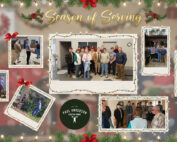“Then the demons came out of the man and entered the pigs, and the herd rushed down the steep bank into the lake and drowned.” -Luke 8:33
This is a strange story to say the least. A quite deranged man met Jesus directly as He got out of a boat with His disciples in the country of the Gerasenes. This man had lived as what you might call a maniac: He wore no clothes, was homeless, slept among the tombs of the dead, and was not sociable in the least. He, or rather the demons in him, spoke with accurate knowledge of who Jesus was, rightly knowing His identity. Jesus knew why this man was not in his right mind. He knew demons dwelled in him, and He knew these demons knew Him. Asking the possessed man his name, Jesus received the reply, “Legion,” alluding to the fact of a great many within him.
The cure for this man was to rid him of the demons, restoring him to who he was in God’s image. Apparently, it was not an easy task for Jesus to cast them out of this man because the demons adamantly refused His command to leave. They must go somewhere, and they did not want to be cast into the abyss. So, they begged Jesus to allow them to enter into a nearby herd of around 2,000 pigs. Jesus acquiesced to their request. Why? We don’t know. We do know that it would not go well for the pigs. As it happened, the demons drove the pigs to their destruction. They rushed over a steep cliff into the sea below and drowned. I imagine the drowned pigs, now possibly worth nothing, could at least be salvaged for food if tended to quickly, but this was a lot for the herd’s owners to deal with rapidly.
Nothing is said of any liability incurred by Jesus and His disciples in the herd’s destruction. Onlookers would possibly blame Jesus for what they witnessed, or this was a complete mystery to them. Demons and demonology were not an exact science for normal human beings. They were oblivious to any accurate diagnosis of this man’s malady, and not being able themselves to cure him or even know demons possessed him, it was in any case beyond them.
Did these demons have to go somewhere? Did they have to go into the pigs? Did Jesus have other options? We do not know. What we do know is that the demons were better to be in the pigs than in the man.
The ASPCA spends a lot of money on advertising to raise funds to care for mistreated, abused pets. They know how to tug at the heart-strings of pet owners and many others who are hurt by the pain caused to these discarded and neglected animals. It is a most noble cause, for sure, yet the same is not afforded human babies in the womb who are about to be torn limb from limb, burned alive by caustic chemicals, have the arteries and veins in their necks snipped, and many other truly appalling means to snuff out their lives, regardless of the pain they feel. In fact, such is not allowed to be displayed on television or even discussed in any media. It is covered up as though such does not happen tens of thousands of times a day all over the world.
In this historical story told of Jesus, who is truly more important: one man or 2,000 pigs? Are 2,000 pigs of more value than a dirty, smelly, homeless man? Jesus did not think so! The pig owners and many onlookers did. Jesus drew this comparison very pointedly by allowing the demons to do what they requested. We do not know their destination after the pigs drowned. Perhaps they could have gone to such before destroying these pigs. In any case, they destroyed them. Still, Jesus draws this obvious comparison. Was this man’s life worth more than all these pigs?
You are perhaps as enthralled by the restoration Jesus performed on this poor man as the many who were amazed by what they personally witnessed. They observed this man before and after and were astounded by the complete transformation. We do not know if the cost of the destruction of 2,000 pigs was satisfactorily resolved, but we do know that an eternal soul experienced newness of life which extended beyond this life into eternity. We will actually be able to sit down in time eternal with this man and hear his story from his own lips.
The account tells us about more than the restoration of a man. It tells us the real value of one created in God’s image – an image which animals do not share. Animals are an amazing part of God’s creation. Their amazing colors, unique creations, shapes, and instincts are infinitely beautiful. They appeal to the senses of observant and caring animal lovers, which we all should be. However, these do not have God’s full image in them as do men, women, children, and infants. Jesus came to save sinners such as us. He immensely loves those He died to redeem. Animals are not sinners, though; they are not moral beings. We need to love our fellow human creatures made in God’s image as He does. We must love them, serve them, and seek their salvation with the same love He lavishes on us! Are they more valuable to us than many pigs?
“Taste the goodness of the Lord: Welcomed home to His embrace, all His love as blood out-poured seals the pardon of His grace. Can I doubt His love for me when I trace that love’s design? By the cross of Calvary, I am His and He is mine.”
(Third verse of George Robinson’s hymn, “Loved with Everlasting Love,” 1890)
Stay Updated
Sign up for our monthly newsletter and weekly devotional











